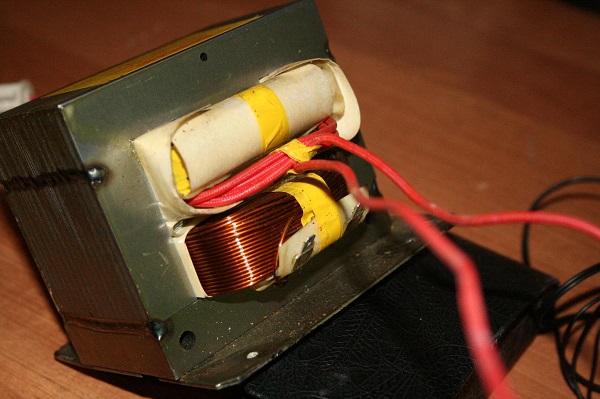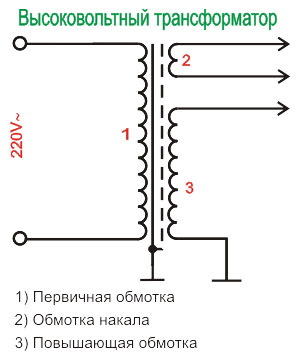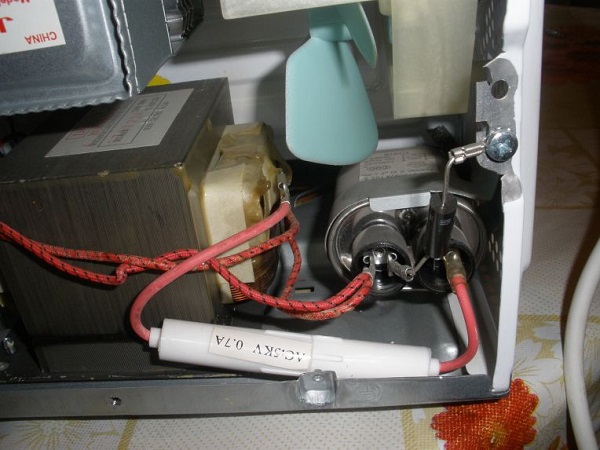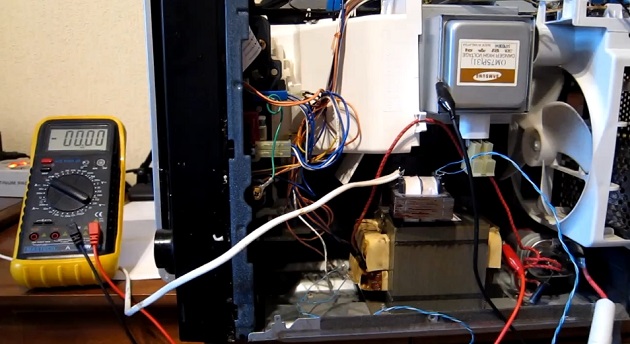Troubleshooting High Voltage Microwave Transformer
Microwave ovens heat the products Microwave radiation. A transformer is an important element of a ray-generating chain. This device converts the magnitude of the normal voltage of a household network supplied to its primary winding to the required for operation. magnetron the output values of the secondary. Often it is he who is the cause of the malfunction of the equipment, so special attention is paid to checking the microwave transformer. When working independently, it is advisable to use a safe way to examine the device
Content
High-voltage transformer in the electric circuit of the furnace
The high-voltage transformer of a microwave oven is a device consisting of a magnetic core, a frame, one primary winding and two secondary ones. The latter feed magnetron circuit: filament and anode line. The first is made of thick wire, and the voltage at its output is a few volts (about three). The second (anode) secondary winding creates an alternating voltage of up to 4 kV at the output. 220 V is supplied to the primary winding from the network.

Transformers of microwave ovens, produced by various manufacturers, differ not only in their appearance: size, mounting options. They are produced in different capacities, class. Also excellent are the output voltages of the secondary windings, the number of turns and the thickness of the wire in them (hence the resistance).
The secondary high-voltage winding is shorted to the case, as is one of the outputs of the magnetron.
AT microwave circuit diagram In addition to the high-voltage transformer, the following elements are included:
- high voltage capacitor and diode;
- magnetron;
- Limit switches;
- fuse;
- electric motors: platforms (turns it inside the microwave cabinet) and fan;
- control unit.
In expensive models, furnaces are used instead of transformers. impulse unitshaving a more complex device, but less weight.
Possible faults of the transformer and their signs
Check the microwave transformer should be arranged in case of poor performance of this household appliance, or when it does not function at all. Symptoms transforming device such:
- a sufficiently strong hum (noise) starts to come from the equipment after switching on;
- dishes placed on the platform are not heated at all or are exposed to slight heating;
- during operation, the smell of burning insulation appears.
If such signs appear, it is better not to use the device before repairing it. In the latter case, it is necessary to disconnect it from the network immediately to avoid even greater breakdowns.
It must be remembered that electrical breakdowns occur during power surges supply network.If this was the case, then at the slightest hint of a malfunction, you should proceed to repair, during which a manufacturing defect may be found.
The above manifestations in most cases are caused by several reasons:
- wire breakage of the primary or secondary (step-up) windings, both at the same time (rare case);
- a short circuit between the turns in one of them, or immediately in two;
- breakage or short circuit in the winding of the magnetron's filament circuit.

Transformer magnetic core consists of electrical steel sheets. Noise at the furnace It may also appear as a result of their detachment from each other - then it is necessary to change the transformer completely. But this happens very rarely and is easily determined visually.
The absolute majority of problems with the operation of a transformer are connected with its windings.
Secure Verification Procedure
Starting to self-test, you need to stock up on a multimeter (in extreme cases - a bipolar indicator with a built-in power source), screwdrivers with different tips, an ohmmeter,pliers.
The general scheme of safe work is as follows:
- disconnect the device from the power supply;
- unscrewing the screws, remove the casing;
- discharge the capacitor;
- from the transformer carefully remove the terminals;
- check its windings: if the parameters are normal - set in place and looking for other reasons;
- when an open circuit or a closure is found in them, they replace the device;
- the furnace is collected and tested for its performance.
If after assembling the microwave does not function, then you should look for more reasons or resort to testing with the voltage connected.
If, after removing the transformer, traces of insulation are seen on its windings, a strong burning smell emanates from it, then it is no longer suitable for use, and there is no sense in checking. In this case, it will only help device replacement.

Before proceeding with the examination of a transforming device, it is necessary to make sure that it receives power. To do this, use a multimeter to check the availability (having previously connected the device to the network and running the heating program) at the connection points of the primary winding of alternating voltage with a value of 220 V.This work is done with extreme caution to avoid electrical shock.
Since to check the transformer you will need to disassemble the microwave oven, it can be done only after disconnecting it from the mains.
The presence of a high-voltage capacitor capable of maintaining an electrical charge, necessitates its discharge before verification work. This is done by simply closing its contacts between themselves (with a screwdriver, pliers) or on the case when the voltage is turned off.
Ways to diagnose device health
The simplest way to verify the operability of a transformer is to replace an existing device with a known good one.
Safe verification method
The safest way to diagnose is to check the integrity of transformer windings with a multimeter. The whole process is performed sequentially. The resistance of the primary winding and two secondary, dismantled and disconnected transformers are determined by a measuring instrument (set at certain limits). If there is a break on the board will be displayed 1.If the circuit is closed, the indications for the primary winding (the device is set to 200 ohms) must be within 2–4.5 ohms, the filament - 3.5–8 ohms, and for the high-voltage secondary (the switch is set to 2000 ohms) their range is already 140 - 350 ohms.
The output resistance beyond the specified limits indicates the presence of interturn circuit.
When performing measurements, it is required to take into account the magnitude of its own multimeter errors. It is determined by shorting its probes short-circuited in the limit used. The value returned will be an error to consider.
You can either check the transformer in the microwave yourself with the device, or entrust this business to professionals from the workshop. The first case will require knowledge of the elementary fundamentals of electrical engineering and the presence of some working skills.
Voltage test
When the results of measurements correspond to the standard indicators, but the furnace does not work, in order to make sure that the transformer is working, it is necessary to check its operational characteristics.
A dangerous option is to measure the output voltages of the secondary windings. The actions are performed in the following sequence:
- 220 V is supplied to the oven;
- the tester checks the voltage at the output of each winding: for high-voltage it will be about 2 kV, and its magnitude on the filament will be around 3 V.
In addition to compliance with safety regulations, this method requires the availability of equipment capable of measuring alternating voltage of more than 2000 V.
It is safer to use the following methods.
- Reverse way to check It is conducted by applying to the secondary secondary winding 220 V, and at the output of the primary it should be about 24 V (the average transformation ratio is assumed to be 9.1).
- You can power the primary coil with a voltage of 12 V (from a low-voltage transformer or power supply), then the secondary should be approximately 109 V.
- Also, the circuit between the turns is present if the transformer device is heated at idle.
- If it heats up when there is a load in the secondary circuits, and after it is disconnected, it ceases, then the reason should be sought further according to the scheme.
The choice of method of testing in the home of a microwave transformer depends on personal qualifications, knowledge and skills, and the tools available.The safest option - the usual dialing to identify the integrity of the chains or the presence of breaks. The use of a voltage of 220 V during the determination of the device’s performance requires strict compliance with electrical safety measures. When there is uncertainty about one's own capabilities, it is better to seek the help of professionals.


/rating_off.png)












